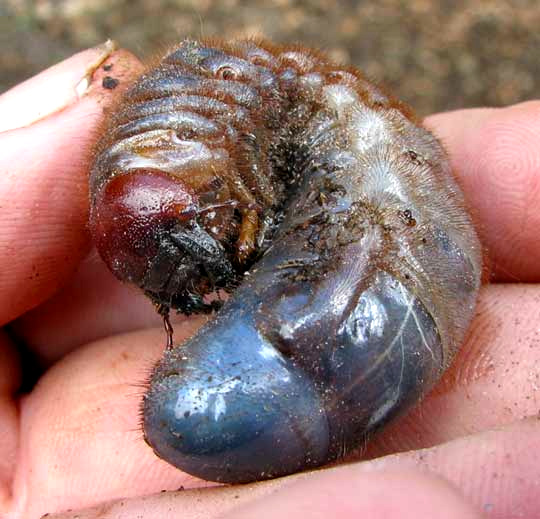Excerpts from Jim Conrad's
Naturalist Newsletter
from the December 5, 2010 Newsletter issued from Hacienda Chichen Resort beside Chichén Itzá Ruins, central Yucatán, MÉXICO; limestone bedrock, elevation ~39m (~128ft), ~N20.676°, ~W88.569°
A BIG GRUB
Once again Santos arrived at my door smiling saying, "I think you'd like to see this... " He'd been digging up a flowerbed and had unearthed the item shown below:

If you compare the big grub with the width of my fingers you'll see that this is a pretty big grub -- the largest I've ever seen. Volunteer insect identifier Bea in Ontario did her best on it. She wrote:
I think we can ID it as a ... Scarab beetle larva. But there are many different tribes under Scarab Beetle. The Rhinoceros Beetle subfamily Dynastinae includes the very large Hercules, Ox, and Rhinoceros beetles, but there are over 300 known species of rhino beetle. Thing is, the larvae mostly all look alike! So, I don't think we can really confirm the species unless you keep it until it turns into an adult, but the Rhino Beetle's larval stage can be several years long. The larvae eat rotting wood. Was yours found in rotting wood?
Yes, the soil Santos had been digging in was full of rotting wood. After Googling awhile and comparing lots of pictures, I decided that Bea probably was right as usual, that it was in the Rhinoceros Beetle subfamily. Moreover, of the many species in that subfamily there's one particularly common species "found in every Mexican state," whose grub pictures look just like ours.
That's the Rhinoceros Beetle, STRATEGUS ALOEUS, distributed from Arizona to Georgia and Puerto Rico south to Brazil -- just about all the Americas' hot lowlands. However, there are 31 species of Strategus beetle, so calling it the Rhinoceros Beetle is just an educated guess.
Adult Rhinoceros Beetles are so large, and the males are so impressive with their big "horns," that they're often sold in the pet trade.